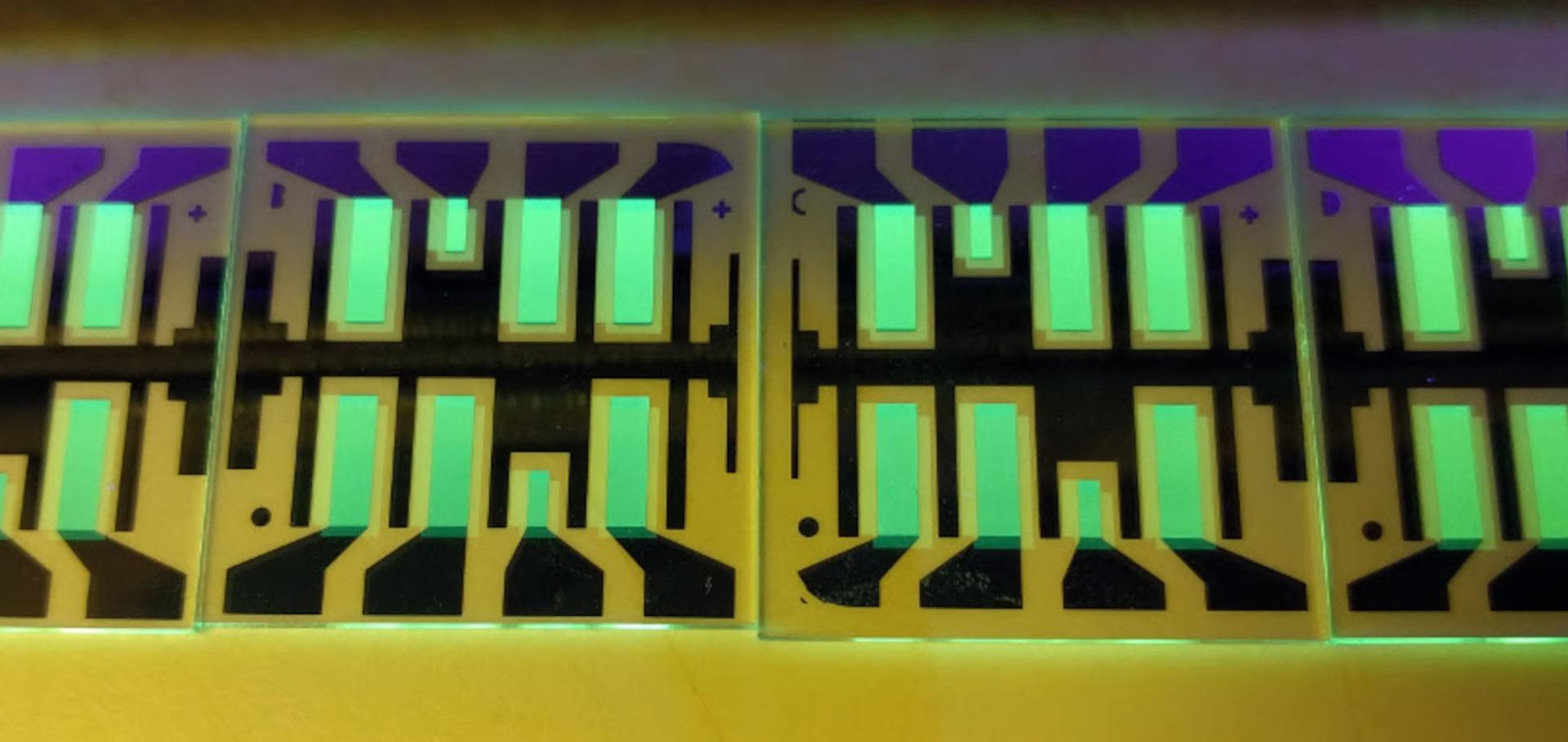Two similar near-infrared (IR) absorbing benzannulated aza-BODIPY dyes as near-IR sensitizers for ternary solar cells.
ACS Appl Mater Interfaces 5:12 (2013) 5609-5616
Abstract:
Ternary composite inverted organic solar cells based on poly(3-hexylthiophen-2,5-diyl) (P3HT) and phenyl-C61-butyric acid methyl ester (PCBM) blended with two different near-infrared absorbing benzannulated aza-BODIPY dyes, difluoro-bora-bis-(1-phenyl-indoyl)-azamethine (1) or difluoro-bora-bis-(1-(5-methylthiophen)-indoyl)-azamethine (2), were constructed and characterized. The amount of these two aza-BODIPY dyes, within the P3HT and PCBM matrix, was systematically varied, and the characteristics of the respective devices were recorded. Although the addition of both aza-BODIPY dyes enhanced the absorption of the blends, only the addition of 1 improved the overall power conversion efficiency (PCE) in the near-infrared (IR) region. The present work paves the way for the integration of near-infrared absorbing aza-BODIPY derivatives as sensitizers in ternary composite solar cells.Evaluation and control of the orientation of small molecules for strongly absorbing organic thin films
Journal of Physical Chemistry C 117:22 (2013) 11600-11609
Abstract:
In the photoactive film of organic solar cells, the orientation of the absorber molecules is one of the key parameters to achieve high absorption and high photocurrents as well as efficient exciton and charge transport. However, most organic absorber small molecules, such as zinc-phthalocyanine (ZnPc) or diindenoperylene (DIP) grow more or less upright standing in crystalline thin films. Considering absorption, this molecular alignment is unfavorable. In this work we control the orientation of ZnPc and DIP in crystalline absorber films by varying the substrate or organic underlayer appropriately. For this purpose, a precise evaluation of the molecular orientation and packing is important. We find that a combination of the methods variable angle spectroscopic ellipsometry (VASE) and grazing incidence X-ray diffraction (GIXRD) can fulfill this requirement. The combination of these complementary methods shows that the growth of DIP and ZnPc is nearly upright standing on weakly interacting substrates, like glass or amorphous charge transport films. In contrast, on strongly interacting metal sublayers and PTCDA templating layers, both molecules arrange in a strongly tilted orientation (mean tilt angle 54 -71 with respect to the substrate normal), inducing a significant enhancement of absorption (maximum extinction coefficient from 0.72 to 1.3 for ZnPc and 0.14 to 0.4 for DIP). However, even when deposited on metal or PTCDA sublayers, not all ZnPc and DIP molecules in the film are oriented in the desired flat-lying fashion. This highlights that classifying organic films into either solely flat lying structures or solely upright standing structures, as often made in literature, is a too simplified picture. © 2013 American Chemical Society.Interlaboratory outdoor stability studies of flexible roll-to-roll coated organic photovoltaic modules: Stability over 10,000 h
Solar Energy Materials and Solar Cells 116 (2013) 187-196
Abstract:
This work attempts to reveal the comparability issues related to outdoor testing procedures of organic photovoltaic (OPV) modules via studies of inter-laboratory long-term outdoor measurements of roll-to-roll coated flexible OPV modules (P3HT:PCBM, inverted architecture) in different geographic locations from both Southern and Northern hemispheres. The interpretation of the module degradation via sub-cell analyses is presented and the poor reproducibility of the module performance linked to the barrier properties of the encapsulation around the device terminals is addressed. We demonstrate that the modules' t80 lifetime may vary between a few hundred to over 10,000 h depending on how well the device terminals are sealed. We additionally demonstrate up to 17 months of stable performance for sub-cells within the modules. Furthermore, the effects of different geographical locations, weather conditions and measurement setups on the comparability of test results are analyzed. A strong link between the device temperature and performance is revealed, which is ascribed to the reaction of PEDOT:PSS layer with water. The estimation of the true performance of the modules by accommodation of variations in testing conditions is performed. Based on the results a set of recommendations from the ISOS-O guiding protocols are highlighted, which can help remove the factors that affect the comparability of the test results. CrownCopyright © 2013 Published by Elsevier B.V. All rights reserved.Photoconductivity as loss mechanism in organic solar cells
Physica Status Solidi - Rapid Research Letters 7:6 (2013) 401-405
Abstract:
We observe that the reverse current under illumination in solar cells containing C60 and ZnPc is dominated by a photoshunt. This shunt, not present in the dark, causes a linear current-voltage relation under illumination showing no saturation. Although observable in bulk heterojunctions, this effect is more pronounced in the presence of a pristine C60 layer. An internal quantum efficiency larger than unity under an applied negative voltage and in the spectral range where C60 absorbs identifies charges which are injected in addition to those photogenerated. The photoshunt is also present in the power-generating region and represents a loss mechanism limiting the fill factor in particular for flat heterojunction devices. © 2013 WILEY-VCH Verlag GmbH & Co. KGaA, Weinheim.Correlation of absorption profile and fill factor in organic solar cells: The role of mobility imbalance
Advanced Energy Materials 3:5 (2013) 631-638


